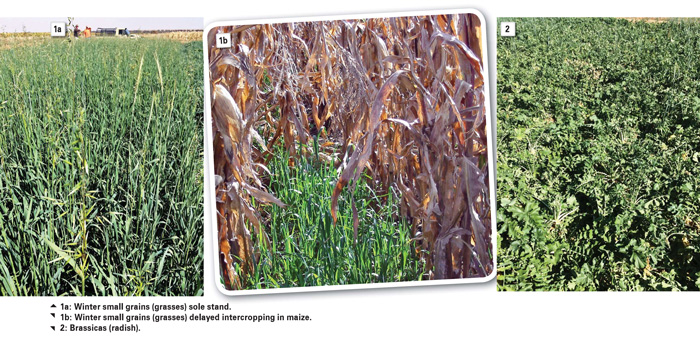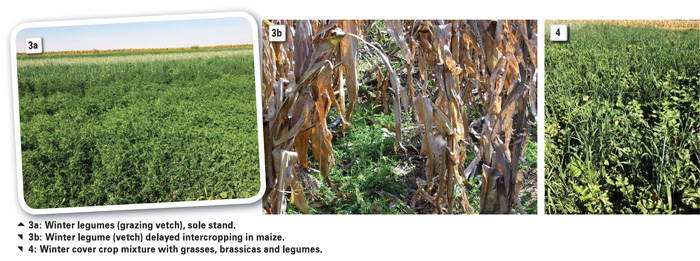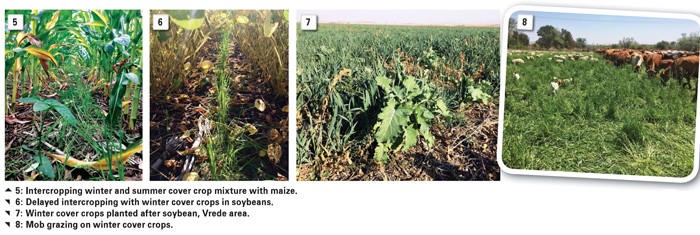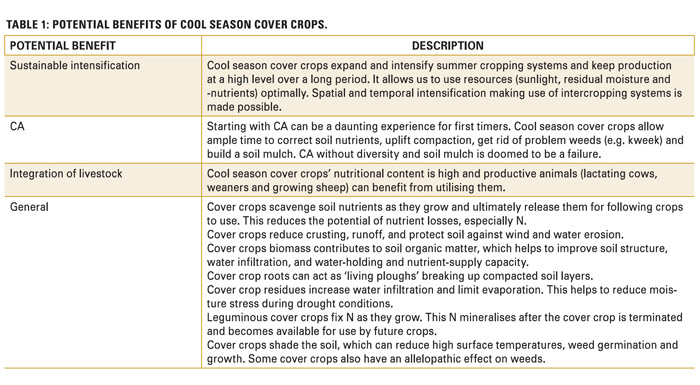April 2018
With a total of only 14% land suitable for arable cropping, South Africa is not well endowed with resources for dryland (rainfed) farming. Soil degradation often occurs due to monoculture cereal production, intensive tillage and limited crop rotation.
In conservation agriculture (CA) systems, crop rotation that includes soybean and sunflower produces limited amount of crop residues with associated problems. These crops are mostly grown on sandy soils and erosion is a common phenomenon, especially when crop residues leave insufficient soil cover during winter. Without sufficient cover these sandy soils often develop crusts after rain events.
The impermeability of these crusts leads to runoff, soil erosion and eutrophication of water resources. When these conditions prevail during and after a winter fallow period, arable soil is vulnerable to degradation, water loss and weed infestation. Winter or cool season cover crops are seen as an ideal CA practice to combat these problems.
Cool season cover crops
The most commonly used cover crops fall into one of three broad groups or families. General information on key aspects of these three groups is mentioned below.

Small grains (grasses)
This functional group includes grasses like rye, triticale, oats and black oats (Photo 1a and Photo 1b). Winter cereals are the most widely used winter cover crops as part of the crop rotation system.
These crops have a fibrous root system that will benefit the formation of soil organic matter deep in the soil profile. Oats is preferred for grazing. Biological production varies between 3 t/ha/year to 5 t/ha/year for the different crops. All crops in this particular functional group will form associations with arbuscular mycorrhiza fungi (AMF).
Rye, when left to mature, has a high C:N ratio and will form a better mulch that will cover the soil for long periods. Planting into rye after termination might lead to the immobilisation of N by microbes in the process of breaking down the mulch.
Winter cereals are typically planted in late summer through early fall (February to March). Planting winter cereals as part of a mixture, after early rain in September in the North Eastern Free State, was also successful and supplied valuable grazing during November.
Grasses respond well to N fertiliser and increased biomass production and root development is common after application. It is suggested that 40 kg - 60 kg N is applied at planting.
Brassicas
Brassica cover crops have grown in popularity recently due to their ability to provide many of the same benefits as grasses, but with residues that break down more rapidly after termination. Radish is by far the most productive cool season crop with between 8 t/ha to 10 t/ha dry matter (DM).
In the water table sandy soils of the North West Free State, it raised the soil carbon at a depth of 80 cm by the value of 0,3% during a single season. Brassicas often used in mixtures include turnips, radish (fodder and tillage) and kale (Photo 2).

Certain brassicas are also becoming well known for their ability to produce a large taproot that is effective in breaking soil compaction. As brassicas decompose, they produce chemical substances that can fumigate the soil and kill plant parasitic nematodes.
Brassicas is a non-mycorrhizal plant family and evolved on disturbed sites with ample available P. When livestock graze on brassica pastures, bloat might occur, but in a mixture, this does not seem to happen. In a pure stand, infestation of bagrada bugs is a common occurrence and can destroy the crop.
Legumes
Legumes in association with nitrogen-fixing bacteria have the ability to ‘fix’ nitrogen from the atmosphere. Inoculation is thus essential. Some of that ‘fixed’ nitrogen will be available to provide low-cost nitrogen for the following summer crop, a very important feature that makes planting of legume cover crops practical and economical. Legumes are valued as cover crops in integrated systems for their high feeding value.
Common legumes used as winter cover crops in cropping systems include vetch (hairy and grazing vetch), sweet clover and crimson clover. To survive the winter, legumes should be planted at such a time that it is well developed before first frost.
In a North West Province trial (Ottosdal) vetch was planted as pure and mixed stands and with a C:N ratio of 15 it contributed to N mineralisation (Photo 3a and Photo 3b). The amount of N added by legumes varies among species, but it is directly proportional to the amount of biomass produced.
The residues of cool season legumes break down fast after termination. Legume plants also have the ability to form associations with mycorrhizas.
Crop mixtures: Why?
Single species leave resources partially unexploited, leaving room for other species to continue or complete the resource exploitation. More diverse systems are hence more productive due to increased niche complementarity or resource use efficiency.
Grass-legume mixtures can be particularly advantageous because they combine the benefits of both and quickly lead to a good canopy cover (Photo 4). The presence of N-rich legume residues can also help break down grass residues more quickly. Disadvantages of mixtures can include increased seed cost and more complicated management.

Potential benefits of cool season cover crops
The potential benefits of cool season cover crops are explained in Table 1.

Practical suggestions implementing cool season cover crops
Planting of cool season cover crops
Depending on the producer’s objectives, three opportunities exist where cool season cover crops can be established:
Putting seed mixtures together
This outcome will depend largely on the producer’s objective. In the drier North West Province, for example, creating water saving mulches should be a priority. Rye and black oats can produce residues that decompose slowly. During the first two months after planting cash crops, evaporation from the soil surface should be curbed with soil cover. In areas where rainfall is more reliable, legumes can reduce input cost by adding N.
A typical mixture for the Vrede and Reitz areas as proposed by Barenbrug, is as follows:
Total seeding density of 24,5 kg/ha.
Terminating the cover crop
The use of a roller-crimper is a handy tool to terminate cover crops. Small grains are very sensitive during the soft dough stage and will terminate through crimping. If left too late viable seed can create problems as weeds during planting of cash crops. Often producers will use glyphosate after rolling small grain to get rid of other weeds.
Brassicas and legumes are not killed successfully by using a roller crimper. A good herbicide programme to terminate legumes and brassicas is a mix of glyphosate and 2,4-D or dicamba. Glyphosate alone is not a recommended programme to kill a legume such as hairy vetch since its performance is variable.
Plant growth regulators such as 2,4-D and dicamba are effective, but also require some delay (one to two weeks) between application and maize planting to avoid herbicide injury. Faster desiccation by using paraquat and 2,4-D or paraquat and atrazine is also a possibility.
Grazing of cover crops
Cool season cover crops are preferably utilised or managed by livestock through mob grazing, also called short duration grazing and ultra-high-density grazing. The main purpose of this grazing practice is to increase competition among livestock, concentrate urine and manure and trampling more plant material onto the soil surface. The amount of biomass utilised and trampled by grazers should be managed, for example through different camp sizes (using electrical fences) (Photo 8).
Mob grazing (e.g. grazing intervals) still needs more research in South Africa. A temporary recommendation is to move livestock daily if shorter intervals are impractical. Creating an inclusion zone where livestock can be ‘parked’ during periods of bad weather, or when you have to work with the animals, will make implementation more manageable.
Conclusion
Cool season cover crops use substantial volumes of water and it is imperative that response farming principles are adhered to. The recharge of the soil profile with soil moisture before planting grain crops is necessary and grain crops should only be planted after sufficient rain (20 mm in 24 hours). As organic matter in the soil increases, more water will infiltrate and more plant available water will be stored in the soil. Pest problems might occur due to the availability of more food.
 For more information contact Gerrie Trytsman at gtrytsman@arc.agric.za.
For more information contact Gerrie Trytsman at gtrytsman@arc.agric.za.
Publication: April 2018
Section: On farm level